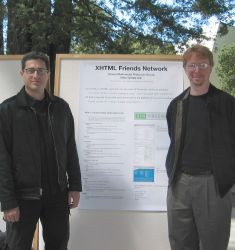Live, from San Jose, it’s the craptastic adventures of SES San Jose 2004! Apparently a trio of SEO experts decided to share their views on “Advanced Design Issues”, which included the use of Javascript and CSS. Because, obviously, expertise in one area automatically confers expertise in another, by which logic I will now declare myself an expert in cellular biology. Photo Matt, from whom I got this URL, drily observed “write HTML like it’s 1997”. Funny, but not quite accurate. Nobody ever wrote Web pages like these people advocate. The idea that some people might do so is a troubling thought. Note to the SES conference organizers: in the future, you might want to think about having people stick to what they know, so as to avoid diluting your conference’s value.
I’m not going to go through and rebut every point, because it would be pointless to do so. Most readers of this site will be able to formulate their own rebuttals, assuming of course that they aren’t incapacitated by laughter, astonishment, or some combination of the two. I will draw attention to the one point they might have gotten partly right. It’s:
Image replacement makes your site inaccessible.
Much has been written about various image replacement techniques and the accessibility problems they present, so that sounds like our trippy triumvirate could have been on the money there. However, were they talking about replacing text with images, as with the FIR and so on, or replacing images with text? Because if it’s the latter, then we have a case of fully consistent unreality. And where do they get off worry about accessibility, given the rest of their advice?
In light of recent commentary from Jeffrey and Molly, among others, I was particularly interested to read the following:
Do not put the entire contents of your page in an <h1>, rather put only half inside an <h1> and stick the other half in an <h2> or other header tag.
It would seem that, at least for some segments of the industry, we are indeed wasting our energy talking about the proper use of heading levels. That’s way, way too far ahead of where they are right now. We need to be telling them about the fundamentals of how document ought to be structured, in the optimistic hope that they’ll one day After all:
Don’t validate your code under any circumstances because hierarchically correct and valid markup is of no use to a search engine.
On which note, can anyone confirm that engines like Google actually make use of heading elements in determining page rank? I’m looking for a link to actual results demonstrating the effect of headings on Google’s ranking of a page; if you have one handy, kindly drop it to me via e-mail. I’d just like to know one way or the other. Google employees are particularly encouraged to write me about this.
I suddenly have the urge to do a round of the SEO conference circuit to set the record straight. I wonder how one might go about that? After all, I’m more of an SEO expert than at least two of these SEO “experts”: Googling for “Eric Meyer” gets you my home page as the #1 result, but searching for one name returns his site at #3, just behind an Assistant Professor of Engineering Management at University of Missouri-Rolla and a blog written by a fan of Howard Dean. The other one didn’t even show up in the first ten Google results, so far as I could tell, and I was searching for his name.
So perhaps it’s time I looked into what it takes to be a presenter at SES/SEO conferences.
Update: please see SES San Jose Corrections for more information, and a much different story than was originally posted here.
 Our
Our